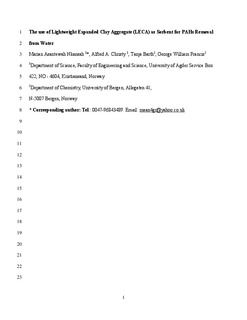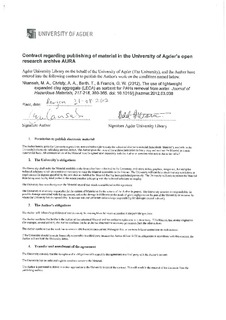| dc.contributor.author | Nkansah, Marian Asantewah | |
| dc.contributor.author | Christy, Alfred A. | |
| dc.contributor.author | Barth, Tanja | |
| dc.contributor.author | Francis, George William | |
| dc.date.accessioned | 2012-08-30T08:29:25Z | |
| dc.date.available | 2012-08-30T08:29:25Z | |
| dc.date.issued | 2012 | |
| dc.identifier.citation | Nkansah, M. A., Christy, A. A., Barth, T., & Francis, G. W. (2012). The use of lightweight expanded clay aggregate (LECA) as sorbent for PAHs removal from water. Journal of Hazardous Materials, 217, 360-365. doi: 10.1016/j.jhazmat.2012.03.038 | no_NO |
| dc.identifier.issn | 0304-3894 | |
| dc.identifier.uri | http://hdl.handle.net/11250/136903 | |
| dc.description | Author's version of an article in the journal: Journal of Hazardous Materials. Also available from the publisher at: http://dx.doi.org/10.1016/j.jhazmat.2012.03.038 | no_NO |
| dc.description.abstract | Lightweight expanded clay aggregate (LECA) has been explored as a sorbent for the removal of PAHs (phenanthrene, fluoranthene and pyrene) from water. The efficacy of LECA as a sorbent for PAHs was assessed using contact time, mass of sorbent and sorption isotherms in a series of batch experiments. Maximum (optimum) sorption was reached at 21 h after which the amount of PAHs sorbed remained almost constant. Batch experiments were conducted by shaking a 100 ml solution mixture of individual PAHs (containing 0.02 mg/L) with LECA. The maximum sorption was 70.70, 70.82 and 72.12%, respectively for phenanthrene, fluoranthene and pyrene when a mass of 0.2 g of sorbent was used. There was an increase in sorption as a result of an increase in mass of sorbent until a maximum was reached at a mass of 4.0 g LECA with 92.61, 93.91 and 94.15% sorption of phenanthrene, fluoranthene and pyrene respectively. Sorption data were fitted to the linearised forms of the Freundlich and Langmuir isotherm models to determine the water-LECA partitioning coefficient. Physical sorption caused by the aromatic nature of the compounds was the main mechanism that governed the removal process while the hydrophobicity of the PAHs also influenced the sorption capacity. LECA can be used as an alternative method for aqueous PAHs removal. (C) 2012 Elsevier B.V. All rights reserved. | no_NO |
| dc.language.iso | eng | no_NO |
| dc.publisher | Elsevier | no_NO |
| dc.subject | PAHs | no_NO |
| dc.subject | sorption | no_NO |
| dc.subject | contaminated water | no_NO |
| dc.subject | LECA | no_NO |
| dc.title | The use of lightweight expanded clay aggregate (LECA) as sorbent for PAHs removal from water | no_NO |
| dc.type | Journal article | no_NO |
| dc.type | Peer reviewed | no_NO |
| dc.subject.nsi | VDP::Mathematics and natural science: 400::Chemistry: 440 | no_NO |
| dc.source.pagenumber | 360-365 | no_NO |
| dc.source.volume | 217-218 | no_NO |
| dc.source.journal | Journal of Hazardous Materials | no_NO |

